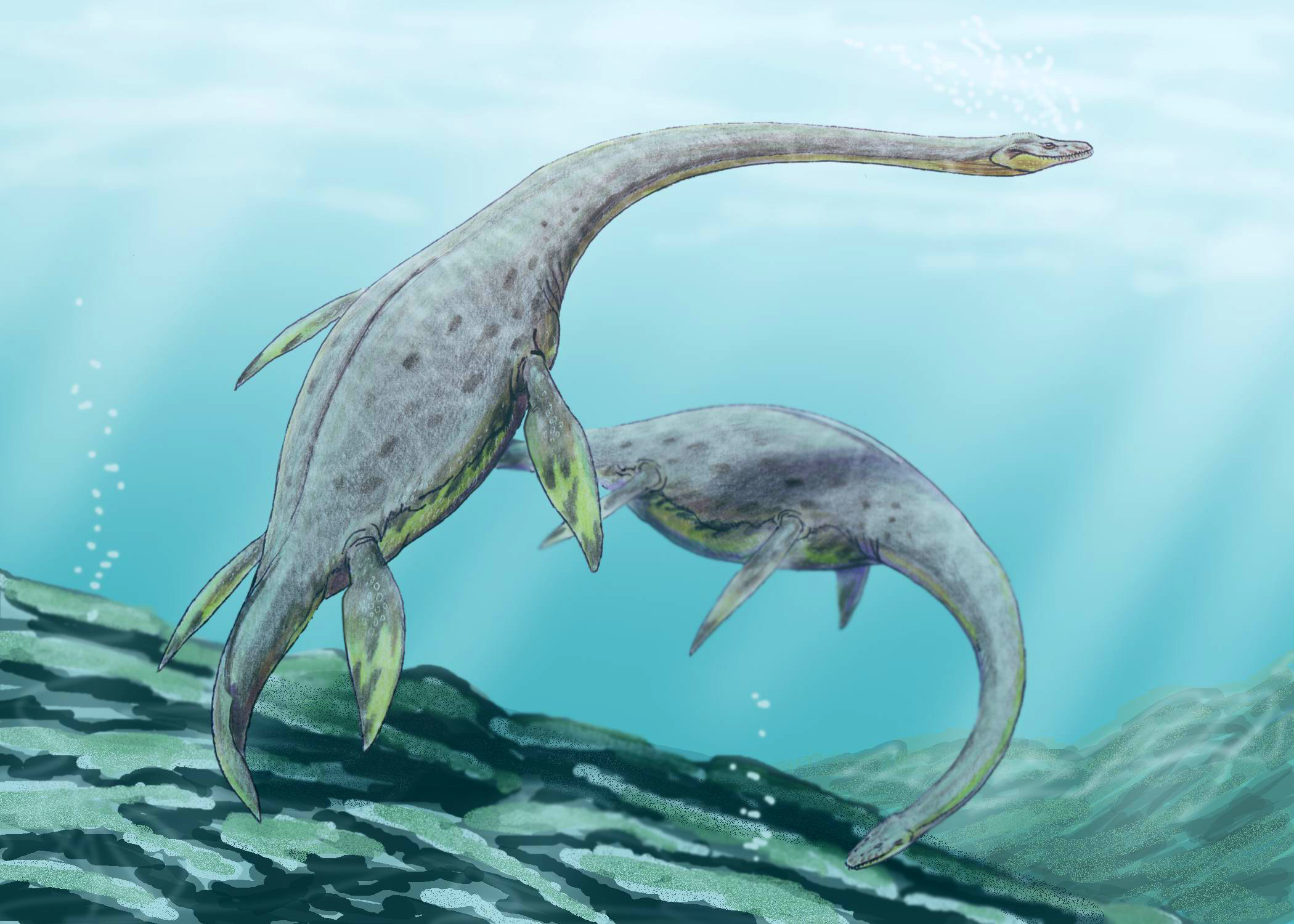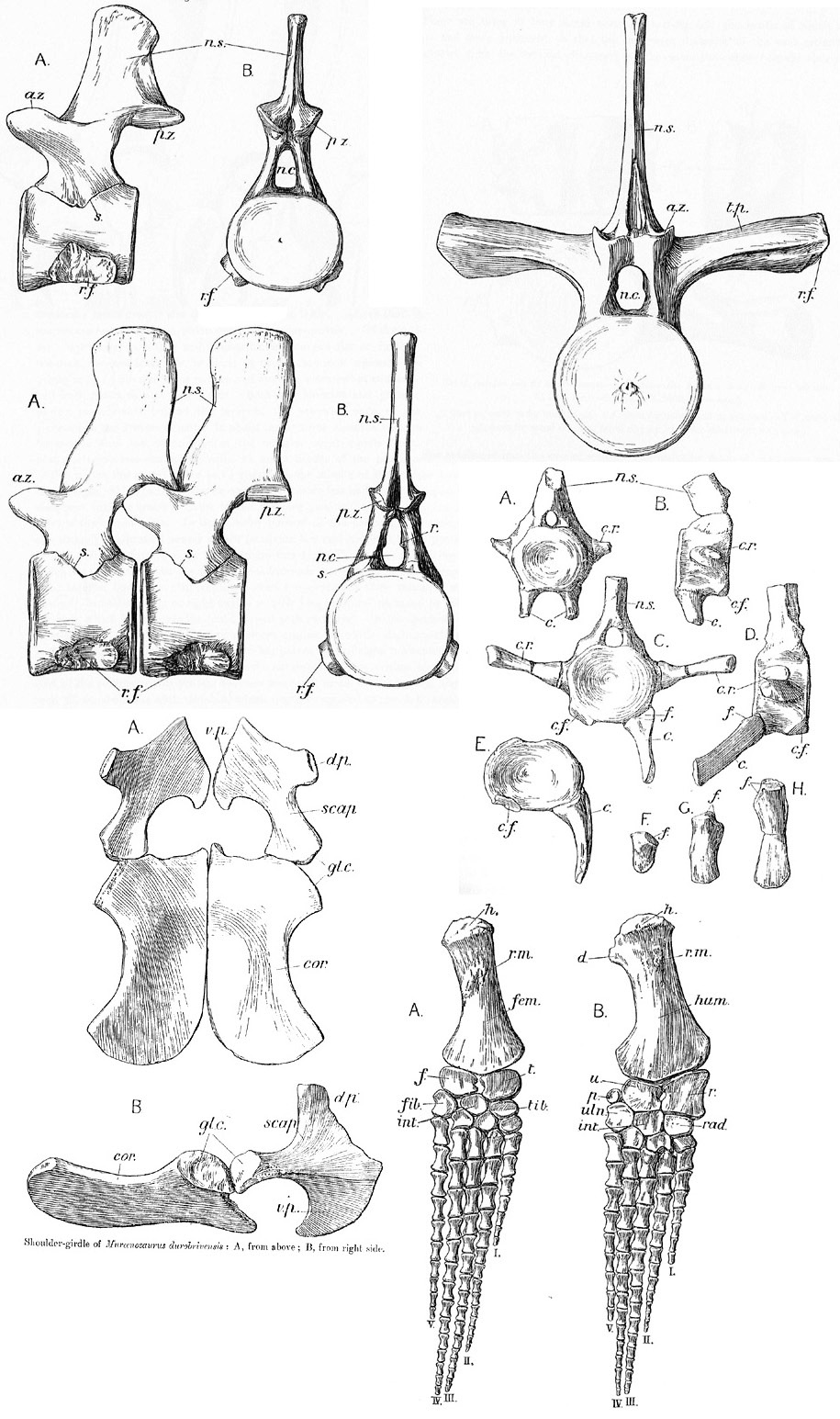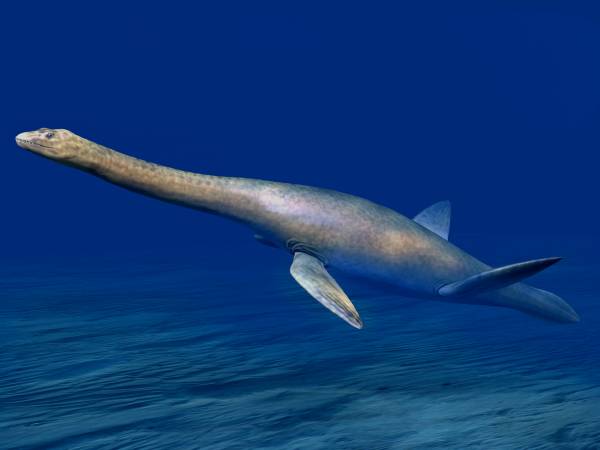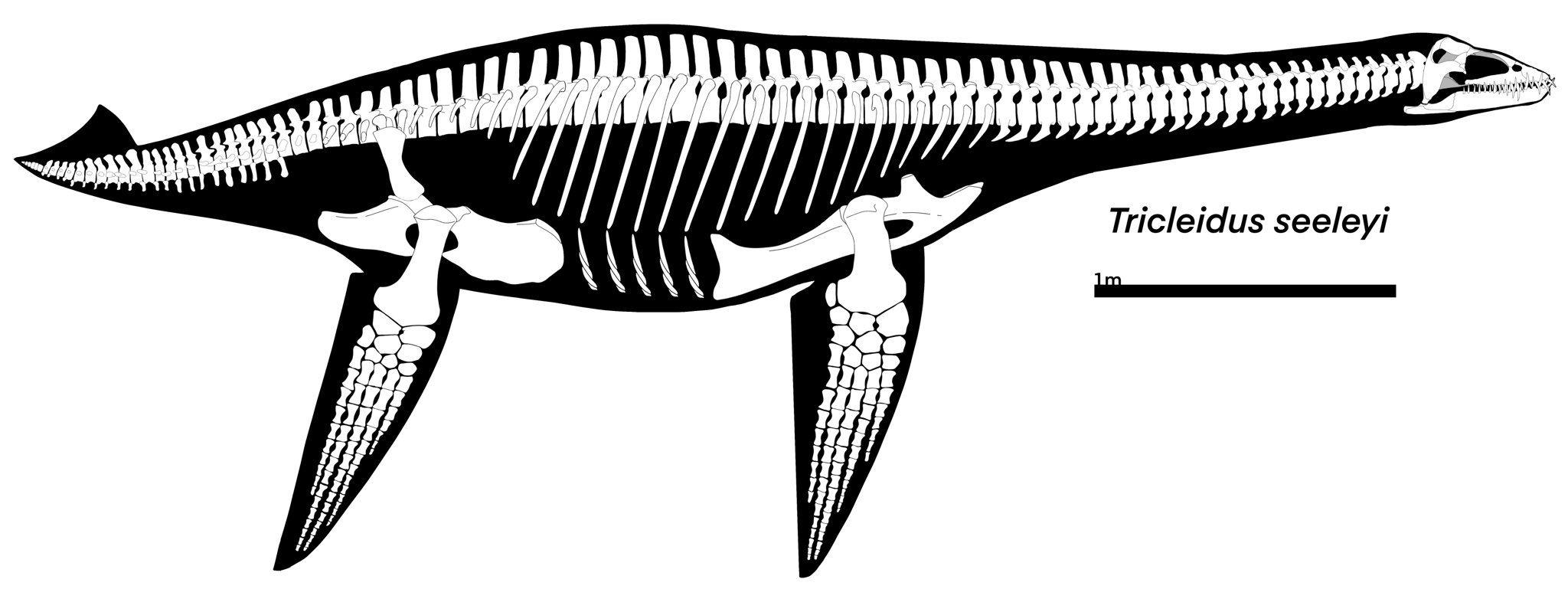|
Cryptoclidids
Cryptoclididae is a family of medium-sized plesiosaurs that existed from the Middle Jurassic to the Early Cretaceous. They had long necks, broad and short skulls and densely packed teeth. They fed on small soft-bodied preys such as small fish and crustaceans. The earliest members of the family appeared during the early Bajocian, and they represented the dominant group of long-necked plesiosaurs during the latter half of the Jurassic. Classification In 2010, two supposed late Cretaceous members of the group were reclassified as other kinds of plesiosauroids. ''Kaiwhekea'' was reclassified to Leptocleididae, and ''Aristonectes'' was transferred to Elasmosauridae. Cladogram A cladogram (from Greek ''clados'' "branch" and ''gramma'' "character") is a diagram used in cladistics to show relations among organisms. A cladogram is not, however, an evolutionary tree because it does not show how ancestors are related to d ... based on Ketchum and Benson (2010): References External ... [...More Info...] [...Related Items...] OR: [Wikipedia] [Google] [Baidu] |
Muraenosaurus
''Muraenosaurus'' (from the Latin "'' Muraena''" meaning "eel" and "''Sauros''" meaning lizard) is an extinct genus of cryptoclidid plesiosaur reptile from the Oxford Clay of Southern England. The genus was given its name due to the eel-like appearance of the long neck and small head. ''Muraenosaurus'' grew up to in length and lived roughly between 160 Ma (million years ago) and 164 Ma in the Callovian of the middle Jurassic. Charles E. Leeds collected the first ''Muraenosaurus'' which was then described by H. G. Seeley.Seeley, HG. 1874. On ''Murænosaurus Leedsii'', a Plesiosaurian from the Oxford Clay. Part I. ''Quarterly Journal of the Geological Society'' 30: 197-208. The specimen may have suffered some damage due to the casual style of Charles Leeds’ collection. The first Muraenosaur was recovered with pieces missing from the skull and many of the caudal vertebrae absent. Because the animal was described from Charles Leeds’ collection it was given the name ''Muraeno ... [...More Info...] [...Related Items...] OR: [Wikipedia] [Google] [Baidu] |
Cryptoclidids
Cryptoclididae is a family of medium-sized plesiosaurs that existed from the Middle Jurassic to the Early Cretaceous. They had long necks, broad and short skulls and densely packed teeth. They fed on small soft-bodied preys such as small fish and crustaceans. The earliest members of the family appeared during the early Bajocian, and they represented the dominant group of long-necked plesiosaurs during the latter half of the Jurassic. Classification In 2010, two supposed late Cretaceous members of the group were reclassified as other kinds of plesiosauroids. ''Kaiwhekea'' was reclassified to Leptocleididae, and ''Aristonectes'' was transferred to Elasmosauridae. Cladogram A cladogram (from Greek ''clados'' "branch" and ''gramma'' "character") is a diagram used in cladistics to show relations among organisms. A cladogram is not, however, an evolutionary tree because it does not show how ancestors are related to d ... based on Ketchum and Benson (2010): References External ... [...More Info...] [...Related Items...] OR: [Wikipedia] [Google] [Baidu] |
Muraenosaurus L2
''Muraenosaurus'' (from the Latin "''Muraena''" meaning "eel" and "''Sauros''" meaning lizard) is an extinct genus of cryptoclidid plesiosaur reptile from the Oxford Clay of Southern England. The genus was given its name due to the eel-like appearance of the long neck and small head. ''Muraenosaurus'' grew up to in length and lived roughly between 160 Ma (million years ago) and 164 Ma in the Callovian of the middle Jurassic. Charles E. Leeds collected the first ''Muraenosaurus'' which was then described by H. G. Seeley.Seeley, HG. 1874. On ''Murænosaurus Leedsii'', a Plesiosaurian from the Oxford Clay. Part I. ''Quarterly Journal of the Geological Society'' 30: 197-208. The specimen may have suffered some damage due to the casual style of Charles Leeds’ collection. The first Muraenosaur was recovered with pieces missing from the skull and many of the caudal vertebrae absent. Because the animal was described from Charles Leeds’ collection it was given the name ''Muraenosaur ... [...More Info...] [...Related Items...] OR: [Wikipedia] [Google] [Baidu] |
Tatenectes
''Tatenectes'' is a genus of cryptoclidid plesiosaur known from the Upper Jurassic of Wyoming. Its remains were recovered from the Redwater Shale Member of the Sundance Formation, and initially described as a new species of '' Cimoliosaurus'' by Wilbur Clinton Knight in 1900. It was reassigned to '' Tricleidus'' by Maurice G. Mehl in 1912 before being given its own genus by O'Keefe and Wahl in 2003. ''Tatenectes laramiensis'' is the type and only species of ''Tatenectes''. While the original specimen was lost, subsequent discoveries have revealed that ''Tatenectes'' was a very unusual plesiosaur. Its torso had a flattened, boxy cross-section and its gastralia (belly ribs) exhibit pachyostosis (thickening). The total length of ''Tatenectes'' has been estimated at . ''Tatenectes'' is related to '' Kimmerosaurus'', although their taxonomic placement has varied. They were once considered to be close relatives of ''Aristonectes'' in the family Cimoliasauridae or Aristonect ... [...More Info...] [...Related Items...] OR: [Wikipedia] [Google] [Baidu] |
Kimmerosaurus
''Kimmerosaurus'' ("lizard from Kimmeridge") is an extinct genus of plesiosaur from the family Cryptoclididae. ''Kimmerosaurus'' is most closely related to ''Tatenectes''. Discovery There are very few fossil remains of ''Kimmerosaurus'' known. In fact, nothing has been found to show what ''Kimmerosaurus'' may have looked like below the neck, although the atlas and the axis are similar to those of the plesiosaur ''Colymbosaurus''. It is this lack of any post-cranial fossils, and the bone similarities that has led to the belief that ''Kimmerosaurus'' fossils could be the missing head of ''Colymbosaurus'', a similar plesiosaur with no known skull fossils. The first part of the genus name of ''Kimmerosaurus'' comes from the location of the first ''Kimmerosaurus'' fossils, Kimmeridge Clay deposits of Dorset, England (these deposits are also the root word for the Kimmeridgian stage of the Jurassic period). The second part comes from the Greek word ('), "lizard". Description As ''K ... [...More Info...] [...Related Items...] OR: [Wikipedia] [Google] [Baidu] |
Cryptoclidus
''Cryptoclidus'' ( ) is a genus of plesiosaur reptile from the Middle Jurassic Period (geology), period of England, France, and Cuba. Discovery ''Cryptoclidus'' was a plesiosaur whose specimens include adult and juvenile skeletons, and remains which have been found in various degrees of preservation in England, Northern France, Russia, and South America. Its name, meaning "hidden clavicles", refer to its small, practically invisible clavicles buried in its front limb girdle. The type species was initially described as ''Plesiosaurus eurymerus'' by Phillips (1871). The specific name "wide femur" refers to the forelimb, which was mistaken for a hindlimb at the time. Fossils of ''Cryptoclidus'' have been found in the Oxford Clay of Cambridgeshire, England. The dubious species ''Cryptoclidus beaugrandi'' is known from Kimmeridgian-age deposits in Boulogne-sur-Mer, France. ''Cryptoclidus vignalensis'', which is now considered undiagnostic, hails from the Jagua Formation of western ... [...More Info...] [...Related Items...] OR: [Wikipedia] [Google] [Baidu] |
Vinialesaurus
''Vinialesaurus'' is a genus of plesiosaur from the Late Jurassic ( Oxfordian) Jagua Formation of Pinar del Río, Cuba. The type species is ''Vinialesaurus caroli'', first described as ''Cryptocleidus caroli'' by De la Torre and Rojas in 1949 under the holotype MNHNCu P 3008, and redescribed by Gasparini, Bardet and Iturralde in 2002. The authors of the 2002 paper considered ''Vinialesaurus'' distinct enough from ''Cryptocleidus'' to warrant its own genus, but it was broadly similar to ''Cryptocleidus''. The name ''Vinialesaurus'' honors Viñales, the town in western Cuba where the fossils of ''Vinialesaurus'' was discovered. These fossils consist of a mostly complete skull, jaw, and portions of the vertebrae. It was a relatively small plesiosaur, reaching in length and in body mass. See also * List of plesiosaur genera * Timeline of plesiosaur research This timeline of plesiosaur research is a chronologically ordered list of important fossil discoveries, controversies ... [...More Info...] [...Related Items...] OR: [Wikipedia] [Google] [Baidu] |
Tricleidus
''Tricleidus'' is an extinct genus of cryptoclidid plesiosaur known from only specimen (BMNH R3539) from the middle Jurassic of United Kingdom. It was first named by Andrews in 1909 and the type species is ''Tricleidus seeleyi''. It was a relatively medium-sized plesiosaur, measuring long and weighing . See also * List of plesiosaur genera * Timeline of plesiosaur research This timeline of plesiosaur research is a chronologically ordered list of important fossil discoveries, controversies of interpretation, taxonomic revisions, and cultural portrayals of plesiosaurs, an order of marine reptiles that flourished duri ... References Cryptoclidids Middle Jurassic plesiosaurs of Europe Fossil taxa described in 1909 Taxa named by Charles William Andrews Oxford Clay Sauropterygian genera {{plesiosaur-stub ... [...More Info...] [...Related Items...] OR: [Wikipedia] [Google] [Baidu] |
Picrocleidus
''Picrocleidus'' is an extinct genus of plesiosaur. It is known only from the type species ''P. beloclis'' from the Middle Jurassic Oxford Clay Formation (Callovian stage) of the United Kingdom.Andrews, Charles W 1910. A descriptive catalogue of the marine reptiles of the Oxford Clay, Part 2. British Museum (Nat. Soc.) 13:139-149. See also * Timeline of plesiosaur research This timeline of plesiosaur research is a chronologically ordered list of important fossil discoveries, controversies of interpretation, taxonomic revisions, and cultural portrayals of plesiosaurs, an order of marine reptiles that flourished duri ... References {{Taxonbar, from=Q9059430 Middle Jurassic plesiosaurs of Europe Fossil taxa described in 1892 Cryptoclidids Taxa named by Harry Seeley Sauropterygian genera ... [...More Info...] [...Related Items...] OR: [Wikipedia] [Google] [Baidu] |
Spitrasaurus
''Spitrasaurus'' is an extinct genus of cryptoclidid plesiosauroid plesiosaur known from the uppermost Jurassic of central Spitsbergen, NorwayLow resolusion pdf /ref> and likely also , . It is named after a |
Pantosaurus
''Pantosaurus'' ("all lizard") is an extinct genus of plesiosaur from the Late Jurassic ( Oxfordian) of what is now Wyoming. It lived in what used to be the Sundance Sea. It was originally named ''Parasaurus'' ("near lizard") by Othniel Charles Marsh in reference to ''Plesiosaurus'', but that name was preoccupied, and Marsh changed it. The species ''Muraenosaurus reedii'' is in fact a junior synonym of ''Pantosaurus''. The holotype YPM 543 is a partial articulated skeleton, partially prepared to yield a distal humerus, four articulated carpals, a fragment of the coracoid, and several isolated cervical vertebrae from the Upper Member of the Sundance Formation. Other material includes USNM 536963, USNM 536965, UW 3, UW 5544 and UW 15938. Palaeobiology ''Pantosaurus'' possesses between 35 and 40 cervical vertebrae, which are very similar in proportion and morphology to those of '' Muraenosaurus leedsii'' from the Oxford Clay Formation (Callovian, Middle Jurassic) of England. The for ... [...More Info...] [...Related Items...] OR: [Wikipedia] [Google] [Baidu] |
Ophthalmothule
''Opthalmothule'' (meaning "eye of the north"), was a cryptoclidid plesiosaur dating to the latest Volgian (around the Jurassic-Cretaceous boundary), found in the Slottsmøya Member Lagerstätte of the Agardhfjellet Formation in Spitsbergen. The type species is ''O. cryostea''. Description ''Opthalmothule'' was a medium-sized plesiosaur, measuring long. It was noted to have unusually large eye sockets, which suggests a paleobiological specialization, such as deep water and/or nocturnal hunting. Along with ''Abyssosaurus'', it is one of the youngest cryptoclidids known from boreal Boreal may refer to: Climatology and geography *Boreal (age), the first climatic phase of the Blytt-Sernander sequence of northern Europe, during the Holocene epoch *Boreal climate, a climate characterized by long winters and short, cool to mild ... regions. The holotype is known from skeletal material that includes a complete cranium and a partial mandible, a complete and articulated cervical v ... [...More Info...] [...Related Items...] OR: [Wikipedia] [Google] [Baidu] |





